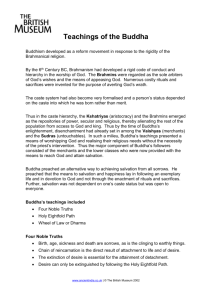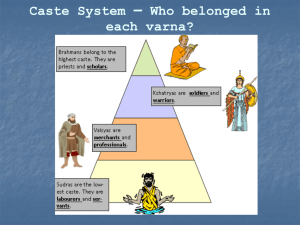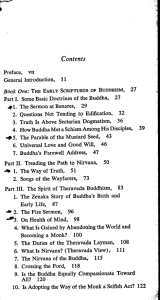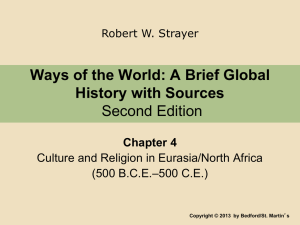Lesson Plan: The Noble Eightfold Path
advertisement
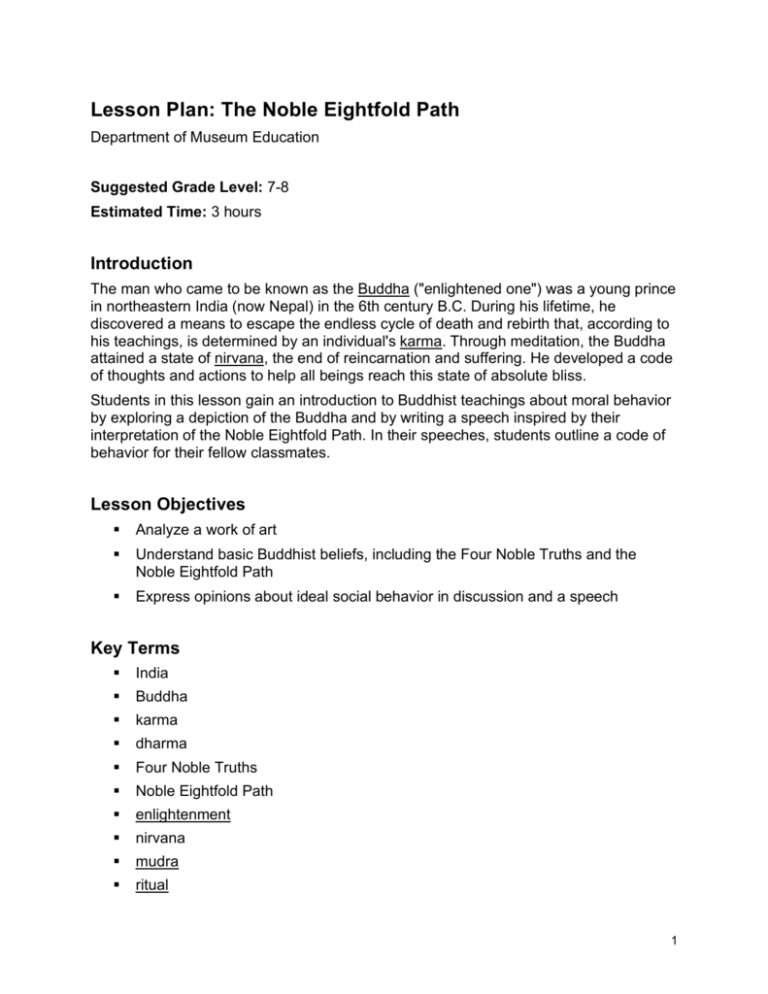
Lesson Plan: The Noble Eightfold Path Department of Museum Education Suggested Grade Level: 7-8 Estimated Time: 3 hours Introduction The man who came to be known as the Buddha ("enlightened one") was a young prince in northeastern India (now Nepal) in the 6th century B.C. During his lifetime, he discovered a means to escape the endless cycle of death and rebirth that, according to his teachings, is determined by an individual's karma. Through meditation, the Buddha attained a state of nirvana, the end of reincarnation and suffering. He developed a code of thoughts and actions to help all beings reach this state of absolute bliss. Students in this lesson gain an introduction to Buddhist teachings about moral behavior by exploring a depiction of the Buddha and by writing a speech inspired by their interpretation of the Noble Eightfold Path. In their speeches, students outline a code of behavior for their fellow classmates. Lesson Objectives Analyze a work of art Understand basic Buddhist beliefs, including the Four Noble Truths and the Noble Eightfold Path Express opinions about ideal social behavior in discussion and a speech Key Terms India Buddha karma dharma Four Noble Truths Noble Eightfold Path enlightenment nirvana mudra ritual 1 Instructional Materials Web sites on the story of Buddha's enlightenment: o His Life and Teaching - http://www.buddhanetnet/buddha.htm o INDOlink: Buddha - http://www.indolink.com/Kidz/buddha.html Pencils Paper Procedures Discussion Ask students if they have heard of Buddhism or the Buddha and ask them to talk freely about what they may know about this religion and its founder or where they have seen images related to it (in books, at home, in a Chinese restaurant, for example). Explain to students that Buddha was a Hindu prince who challenged existing beliefs when he learned about suffering around him. Briefly describe the story of Buddha's enlightenment (see recommended references). Ask students why they think it might have been desirable to Buddha for humans to escape the cycle of death and rebirth. Discuss the concept of enlightenment. Ask students if they have experienced a series of events that also has led them to a new and better way of thinking. Have students examine a printout or digital image of Buddha Shakyamuni. Ask students to describe the details of the work, guiding them to each of the significant features of the enlightened Buddha. o ushnisha o urna o short hair o elongated earlobes o mudras Explain that in most representations the enlightened Buddha can be recognized by speech, Buddha introduced his understanding of the Four Noble Truths. o All life is suffering. o Suffering is caused by desire. o To eliminate suffering, eliminate desire. o To eliminate desire, follow the Noble Eightfold Path. Discuss students' initial interpretation. Tell students that in Buddhism, an individual is not judged by God. Morality is left up to the individual and is expressed through accumulated actions (karma). The Noble Eightfold Path is at the center of daily Buddhist practices. It is not a ritual performed by priests but a 2 guide for all people to live by dharma). It means adopting right (true or correct) views, right thoughts, right conduct, right speech, right livelihood, right effort, right mindfulness (putting aside greed and distress), and right meditation. The reward for following the Noble Eightfold Path is the achievement of nirvana. Activity o Write the elements of the Noble Eightfold Path on the chalkboard and ask students to discuss their possible meanings for 10 to 15 minutes. o Have students discuss the elements of the Noble Eightfold Path in relation to students' behavior in their classroom and school for another 10 minutes. o Ask students to complete a two- to three-page speech titled "How to Be More Compassionate in School," in which they prescribe a code of living for fellow students in their classroom or at school. Ask them to provide examples of how the lives of their fellow students might be improved by such actions. o Organize a "day of sharing." Have students designate a special place in the classroom and read their speeches aloud or post speeches for other students to read. Evaluation Base students' achievements on their participation in class discussions and oral presentations. How much do their comments and speeches reveal an understanding of basic Buddhist beliefs? Did students present thoughtful, critical reflections on these beliefs and their relationship to group behavior in school? Follow-up: Use this lesson as a preparatory exercise for students' participation in the Gandhi/King Legacy Celebration of Peace Essay Contest. The contest is sponsored by the Dharma Foundation, the Indo-American Center, and the Center for Asian Arts and the Media at Columbia College. For more information see www.indoamerican.org/gandhiking. Glossary Buddha (n) historical figure, Buddha Shakyamuni, who lived in India in the sixth century B.C. During this lifetime, Shakyamuni discovered a means to escape the endless cycle of death and rebirth that, according to his teachings, is determined by an individual's karma. Through meditation Buddha attained a state of being known as nirvana, signifying the merging of the inner spirit with the void from which all reality is believed to emerge. Buddha's teachings developed into what in known today as Buddhism; literally means "the enlightened one;" a follower of the Buddha's teachings; the religion born of Buddha's teachings. 3 dharma (n) rules of religious and social conduct that are one's duty to follow. Dharma is determined by religion (Hinduism, Buddhism, or Jainism) and birth (see caste); often capitalized enlightenment (n) attainment of perfect knowledge and integration with the universe, as believed in Buddhism; the spiritual goal of Buddhism (see nirvana); literally "to become extinguished" karma (n) attainment of perfect knowledge and integration with the universe, as believed in Buddhism; the spiritual goal of effect of past actions; influence of past deeds in determining one's status in this life and the next mudra (n) one of numerous symbolic hand gestures that indicate concepts, such as reassurance or meditation, of Hinduism and Buddhism nirvana (n) Buddhist concept referring to release from the endless cycle of rebirth caused by one's accumulated karma; the end of suffering; salvation ritual (n) ceremony related to religious practice or social customs urna (n) tuft of hair on the forehead of the Buddha, represented as a dot or jewel and which signifies his wisdom ushnisha (n) prominent bump on the top of Buddha's head, which refers to his wisdom and openness as an enlightened being Illinois Learning Standards Fine Arts: 27 English Language Arts: 2–4 Social Science: 18 4





